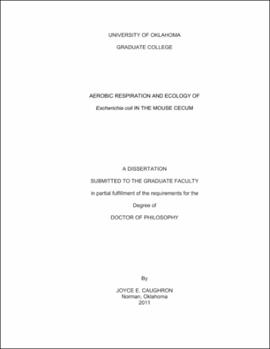| dc.description.abstract | The gastrointestinal tract contains a complex microbial ecosystem that exists in a symbiotic relationship with its host and plays an important role in maintaining human health. Escherichia coli, a facultative anaerobe, is a commensal bacterial resident of the gastrointestinal tract and has demonstrated the importance of aerobic respiration for its survival in this competition rich ecosystem. The gastrointestinal tract is also host to a diverse and numerically dominant population of obligately anaerobic bacteria that coexist with E. coli in the mucus layer adjacent to the intestinal wall. This dissertation explores the relationship between E. coli and its oxygen sensitive microbial cohorts in mouse cecum mucus. We produced and in silico model of oxygen diffusion from the intestinal wall into the mucus layer in the absence and presence of aerobically respiring E. coli. The model predicts a decrease in the oxygen concentration of the mucus layer in the presence of aerobically respiring E. coli. In order to confirm the prediction of our model, we performed T2* weighted Magnetic Resonance Imaging (MRI) on the ceca of conventional mice, mice that had their native facultative anaerobes removed by treatment with streptomycin sulfate, and mice that were treated with streptomycin sulfate and subsequently colonized with E. coli MG1655 wild-type Nalr Strr or E. coli MG1655ΔcydAB ΔcyoAB::cat Strr, and isogenic cytochrome oxidase mutant that is unable to respire oxygen but is otherwise identical to the wild-type. T2* weighted MRI confirmed the prediction of our model in that conventional and wild-type colonized mice indicate lower cecal oxygen concentration than streptomycin sulfate only mice or those colonized with the cytochrome oxidase mutant. In order to examine the hypothesis that aerobic respiration in E. coli has an impact on the ecology of cecum mucus, we conducted 16S rRNA pyrosequencing surveys of the same experimental conditions for the MRI experiment. The results indicate a difference in β-diversity between our streptomycin treated only mice and each of those that had been treated with streptomycin and subsequently colonized with the wild-type or the cytochrome oxidase mutant. The results of this work lay the foundation for examinations of the affect of probiotic E. coli strains on the total intestinal microbiota. | |
